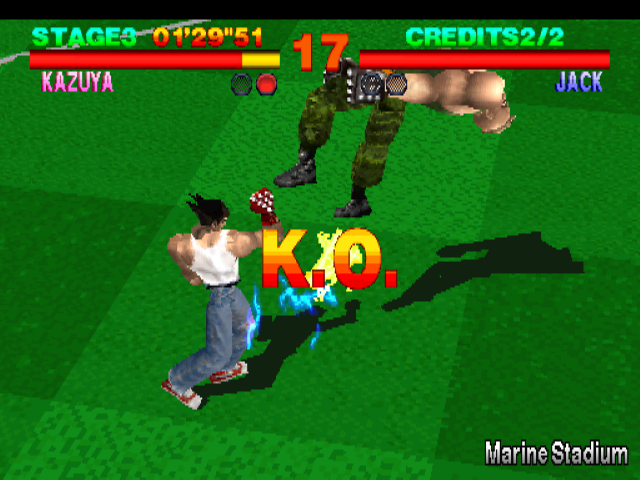
Back when SEGA released Virtua Fighter in 1993 for their powerful Model 1 arcade hardware, Namco was internally testing 3D models and animations with human characters, which would be retooled into the development of a 3D fighting game, as Namco actually ended up hiring several staff that worked on the first Virtua Fighter itself, including its director. While figuring out the approach to make realistic fighting moves along with a fluid 60fps framerate on a time where this was non-existent was really tough, the mix of expertise between the new developers working on the animations and the old staff helping on data compression, as well as Sony's blessing to use the Playstation as a base to make a cheaper arcade hardware for the game, Tekken ended up as a big step for the industry, and one that would quickly make the jump to the PS1 itself with virtually no compromises.
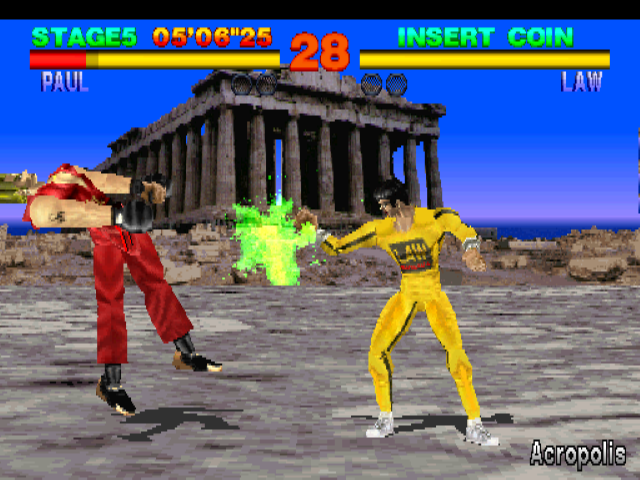
Tekken's control scheme is quite different to every other fighting game, both 2D and 3D (back then and even today): Most 2D fighters like Street Fighter and KOF had 4 to 6 buttons, with punches and kicks of different strengths, while Virtua Fighter and other SEGA 3D fighting games used a Punch button, a Kick button and a Guard button. However, while Tekken had two buttons for punches and two buttons for kicks, these corresponded to each fighter's limb instead of different strengths, and combined with typical fighting game commands (like quarter-circles and dragon-punches) as well as strings (combination of buttons), does make for a robust beginning...though as we are talking about the first game, there are only a few commands per character.
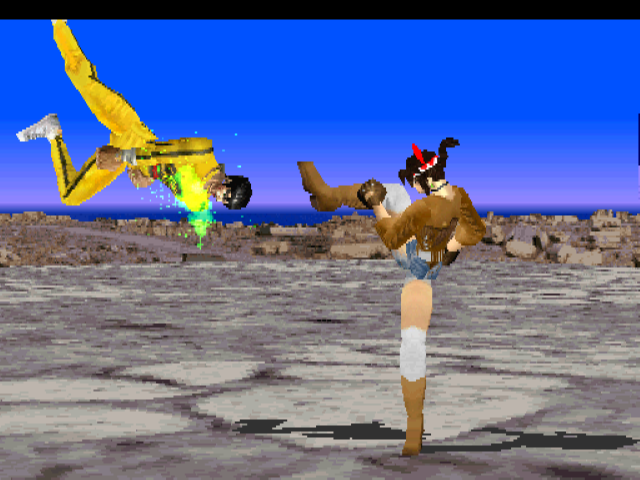
For today standards, the game looks really rough, but at the time, having 3D characters move around and fight like that was groundbreaking, with every knock out showing right after a slow motion replay of the finishing blow from a different camera angle; while Virtua Fighter also had replays, the slow-mo in here as well as better camera angles give those moments some extra strength and coolness. Speaking of camera angles, something exclusive to this first entry is that you could change the camera angle to be from above at the start of each round...though it only serves as a cool thing instead of something necessary, and this vibe is carried over to the gameplay itself, as balance is non-existent and characters do high damage with few moves.
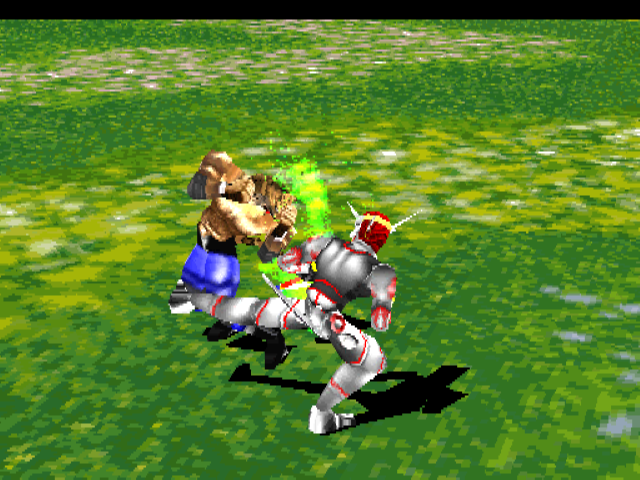
Despite the limited movesets and rough graphics, Tekken showed off a lot with the creative characters and the stages where you fight all around the world. However, the first Tekken still shows signs from "early installment weirdness", from the "moon jumping" from VF1 also being present here, no sidestepping, odd designs/models for certain characters that wouldn't be seen again, the hidden sub-bosses fought depending of which character you picked at the beginning and the final boss Heihachi being inaccessible in the Arcade version, and the CGI used through the Arcade version animated portraits and PS1 intro/endings being even more dated that the in-game graphics.
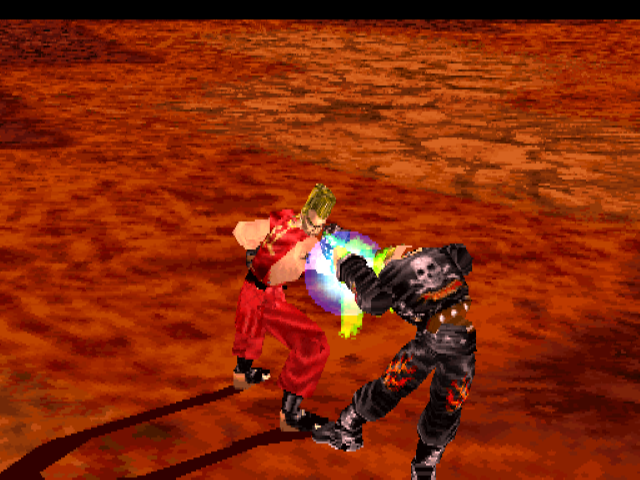
While Tekken seemingly didn't sell that much in Japanese arcades, it took over the rest of the world like a storm, and ended up dominating at many homes with Playstation consoles. The PS1 port on top of introducing character endings, an arranged soundtrack and being able to unlock the bosses, it also followed on what Ridge Racer did and had a boot minigame based off Galaga's challenging stages. Perfecting this minigame would unlock "Devil Kazuya", which while was only a costume here, was a cool bonus and a hint of what would he eventually become since this game.
The very first Tekken installment definitely was a very solid base to develop engaging gameplay on sequels, and Tekken 2 would make sure to tweak what was here with more movesets, fleshing out character designs (including making the sub-bosses more unique), and even using almost every music track from Tekken 1 for the sub-boss themes. As a piece of history showing the franchise's origins, Tekken ends up standing surprisingly well as it can be described as the most basic version of Tekken ever...and yet feeling like Tekken with the familiar moves, animations and juggles. And as a little game to revisit every now and then for dumb fun, it was well designed enough to not feel like a janky attempt at a 3D fighting game like many others would come out at that time...so yeah, it still can be fun today!
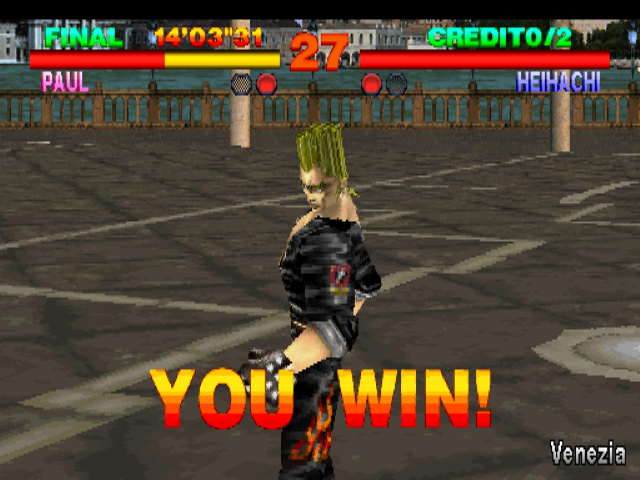
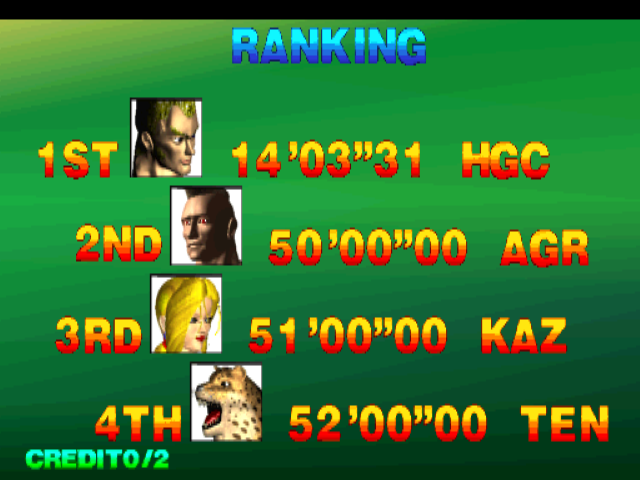
Spanish translation with DeepL. All screenshots were captured by myself.
Español
Cuando SEGA lanzó Virtua Fighter en 1993 para su potente hardware arcade Model 1, Namco estaba probando internamente modelos y animaciones en 3D con personajes humanos, que se reajustarían en el desarrollo de un juego de lucha en 3D, ya que Namco acabó contratando a varios miembros del personal que trabajó en el primer Virtua Fighter, incluido su director. Si bien es cierto que el enfoque para hacer movimientos de lucha realistas junto con una fluida velocidad de fotogramas de 60 fps en una época en la que esto no existía fue realmente difícil, la mezcla de conocimientos entre los nuevos desarrolladores que trabajaban en las animaciones y el antiguo personal que ayudaba en la compresión de datos, así como la bendición de Sony para utilizar la Playstation como base para hacer un hardware arcade más barato para el juego, Tekken terminó siendo un gran paso para la industria, y uno que rápidamente daría el salto a la propia PS1 sin prácticamente ningún compromiso.

El esquema de control de Tekken es bastante diferente al de cualquier otro juego de lucha, tanto en 2D como en 3D (en aquella época e incluso hoy en día): La mayoría de los juegos de lucha en 2D, como Street Fighter y KOF, tenían de 4 a 6 botones, con puñetazos y patadas de diferente intensidad, mientras que Virtua Fighter y otros juegos de lucha en 3D de SEGA utilizaban un botón de puñetazo, otro de patada y otro de guardia. Sin embargo, mientras que Tekken tenía dos botones para puñetazos y dos botones para patadas, éstos correspondían a la extremidad de cada luchador en lugar de a diferentes fuerzas, y combinados con los típicos comandos de los juegos de lucha (como cuartos de círculo y golpes de dragón), así como las cadenas (combinación de botones), hacen que el comienzo sea robusto... aunque como estamos hablando del primer juego, sólo hay unos pocos comandos por personaje.

Para los estándares de hoy en día, el juego tiene un aspecto muy tosco, pero en su momento, tener personajes en 3D moviéndose y luchando de esa manera fue innovador, con cada nocaut mostrado justo después de una repetición a cámara lenta del golpe final desde un ángulo de cámara diferente; aunque Virtua Fighter también tenía repeticiones, la cámara lenta de aquí, así como los mejores ángulos de cámara, dan a esos momentos una fuerza y una frescura adicionales. Hablando de ángulos de cámara, algo exclusivo de esta primera entrega es que podías cambiar el ángulo de la cámara para que fuera desde arriba al comienzo de cada ronda... aunque sólo sirve como algo genial en lugar de algo necesario, y esta sensación se traslada a la propia jugabilidad, ya que el equilibrio es inexistente y los personajes hacen mucho daño con pocos movimientos.

A pesar de los limitados conjuntos de movimientos y los toscos gráficos, Tekken se lució con los creativos personajes y los escenarios en los que se lucha por todo el mundo. Sin embargo, el primer Tekken sigue mostrando signos de la "rareza de las primeras entregas", desde el "salto a la luna" de VF1 que también está presente aquí, la ausencia de esquivas, los extraños diseños/modelos de ciertos personajes que no se volverían a ver, los sub-jefes ocultos contra los que se luchaba dependiendo del personaje que se eligiera al principio y el jefe final Heihachi que era inaccesible en la versión Arcade, y el CGI utilizado a través de los retratos animados de la versión Arcade y la introducción/finales de PS1 que eran incluso más anticuados que los gráficos del juego.

Aunque parece que Tekken no vendió mucho en los salones recreativos japoneses, se impuso en el resto del mundo como una tormenta, y acabó dominando en muchos hogares con consolas Playstation. El port de PS1, además de introducir los finales de los personajes, una banda sonora arreglada y la posibilidad de desbloquear a los jefes, también seguía la estela de Ridge Racer y tenía un minijuego de arranque basado en las desafiantes fases de Galaga. Al perfeccionar este minijuego se desbloqueaba a "Devil Kazuya", que si bien era solo un disfraz, era un bonus genial y una pista de lo que acabaría siendo desde este juego.
La primera entrega de Tekken fue sin duda una base muy sólida para desarrollar una jugabilidad atractiva en las secuelas, y Tekken 2 se aseguraría de ajustar lo que había aquí con más conjuntos de movimientos, ampliando los diseños de los personajes (incluso haciendo que los subjefes sean más únicos), e incluso utilizando casi todas las pistas musicales de Tekken 1 para los temas de los subjefes. Como pieza de la historia que muestra los orígenes de la franquicia, Tekken acaba siendo sorprendentemente bueno, ya que puede describirse como la versión más básica de Tekken de todos los tiempos... y, sin embargo, se siente como Tekken con los movimientos, animaciones y malabares familiares. Y como juego para volver a visitar de vez en cuando por diversión tonta, estaba lo suficientemente bien diseñado como para no parecer un intento de juego de lucha en 3D como muchos otros que salían en aquella época... así que sí, ¡todavía puede ser divertido hoy en día!


Traducción al español hecha con DeepL. Todas las fotos capturadas por mí.
classic!!!!!!
Now this is a good post. Tekken was a huge step-up from the first Virtua Fighter and I loved it since the 2nd game (first one I played).
And if Virtua Fighter is the granddad of modern 3D fighting games, Tekken 3 is the daddy.